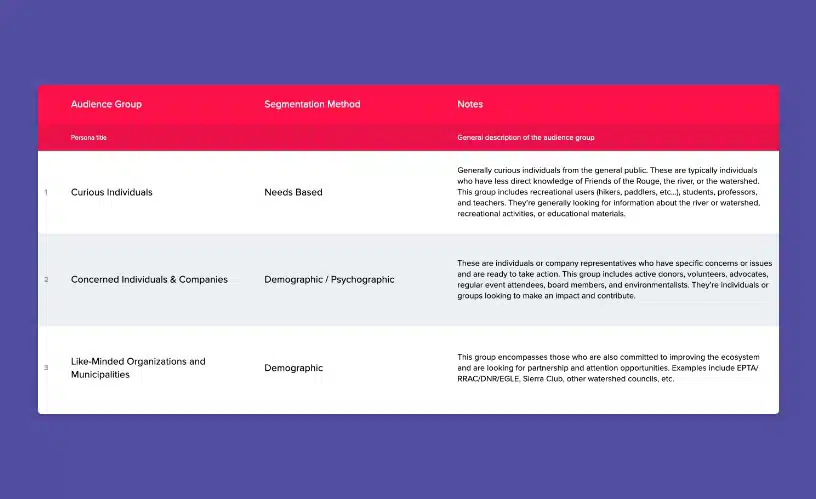How to Define and Segment Your Websites Target Audience

Segmenting your target audience is critical for a successful website. Whether you receive hundreds of visitors or tens of thousands, each user will want something slightly different from your website. You can’t design a website that caters to everyone, so you must identify the most common needs and design to support those best.
This is called segmentation. It’s a method of grouping your target audience into similar buckets, allowing you to prioritize which people are most important and identify the common goals and actions among them. Consider a university website, for example. Universities cater to diverse audiences, including faculty, current students, prospective students, parents, and alumni.

Each of these groups will arrive on the site with different goals, looking for different content and a different frame of mind. By knowing the five audience groups, the website can be designed to support the needs of each by funneling them into areas of the site most appropriate for them.

University websites are an outlier in audience groups, whereas many business websites only have 2 – 4 (important) segments. If we adjust the example just slightly and look at an agency that does educational marketing, we might only have three segments such as marketing managers, individual department heads, and head of admissions.
Segmentation can seem difficult, but six common segmentation methods make the process easy. The methods are geographic, demographic, psychographic, behavioral, needs-based, and transactional.
In this article, we’ll explore each segmentation method so you can identify which is right for your website.
The Six Methods of Segmenting
As mentioned earlier, there are six methods of segmenting your target audience. Before we dive in, it’s important to note that you don’t have to stick to a singular segmentation method. You can combine several segmentation methods to understand your target audience best.
Now, let’s start with the most traditional methods and work toward newer methods enabled by modern technology.
Geographic Segmentation
Geographic segmentation is grouping your target audience by location. Typically you’d look at factors like country, city, state, or region. Geographic segmentation is one of the oldest methods available and was most relevant when most businesses were conducted based on locality. As you might expect, geographic segmentation is best for physical locations.
That said, there are times when you might use geographic segmentation based on the attributes of a given region. If you sell low-cost and expensive products or services, you might use geographic segmentation to group your audience based on a region’s average cost of living. Areas with higher living costs would be directed towards more expensive offerings and vice versa.
Demographic Segmentation
Segmenting by demographic is the other most traditional approach. Demographics are individual attributes such as age, gender, income, education level, and occupation. It used to be hard to target individuals based on interests, lifestyles, and values. As a result, marketers, and advertisers had to look at broad demographic characteristics to identify what type of people typically fit their buyers. When running a traditional TV commercial, you couldn’t target someone’s interest, so you had to pick which geographic and demographics best aligned with your product or service.
That said, there are still many situations where demographics play a role.
In many B2B businesses, you might segment your audience by job title, education, income, or company they work for. In a B2C business, your product might best fit different age ranges or family sizes. Disney resorts, for example, have several demographic-based audience segments, including young parents and grandparents.
Psychographic Segmentation
Psychographic segmentation is one of the more common methods of late. Where demographics look at personal attributes, psychographics look at thought patterns—specifically values, lifestyles, beliefs, and personality traits.
Marketers often find it’s more accurate to group people based on how they think than how old they are, where they live, and their gender. For example, the desire for an outdoor lifestyle certainly isn’t limited to age, education, gender, or occupation.
Digital marketing has made psychographic segmentation possible. Social advertising, content marketing, social media, and website personalization can be leveraged to reach people with common interests, values, lifestyles, or beliefs.
Take an all-natural skincare brand, for example. The audience isn’t likely to be region specific, and while there might be some demographic overlap, demographics won’t be the primary factor for being an ideal customer. Instead, they’re likely to share values like being environmentally conscious, humane testing practices, and self-care.
Behavioral Segmentation
Psychographic segmentation looks at how people think, and behavioral segmentation looks at how people act. Examples include buying patterns, attitude towards your brand, other brands one engages with, how knowledgeable one is, etc…
Some brands have learned that people who behave a specific way are much more likely to purchase than ones that don’t. For example, you may learn that active social media users are your top purchasers. Or, you might find that people who frequently purchase skin care products are more likely to purchase high-quality coffee.
Advertising platforms like Meta, Instagram, and Google Ads offer an automatic method of behavioral segmentation called “lookalike audiences.” These platforms have an algorithm that can target individuals who behave similarly to those landing on your website.
While behavioral segmentation can be effective, it typically takes significantly more market research to identify the common behaviors your ideal customers share. Once discovered, it can be a powerful segmentation method.
Needs-Based Segmentation
Needs-based segmentation focuses on the specific problems or your target audience is trying to solve. This is particularly effective with service-based businesses, especially ones with multiple service offerings. A digital marketing company might offer web design, digital advertising, search engine optimization, and content marketing. Some customers might be interested in a comprehensive solution and want all the services, whereas others need a website redesign.
For a B2C example, financial planners might offer budgeting, retirement, estate planning, and investment advice. Individuals interested in budgeting are unlikely to need estate planning or investment advice. They’re also unlikely to share demographic or psychographic commonalities. In this case, segmenting them by need will be most effective.
Transactional Segmentation
The final segmentation method is transactional. Transactional segmentation involves grouping your audience based on purchase behavior. This method allows you to tailor your marketing campaigns based on your knowledge of their purchasing behavior. Common examples include repeat buying campaigns, promoting products that are frequently purchased together, and special event-based sales (birthdays, holidays, etc…)
Now that we’ve covered the six segmentation methods let’s discuss how to figure out which method best fits and how to go about segmenting.
How To Determine Segmentation Method(s)
You can’t segment your target audience if you don’t understand them. The first step in determining the ideal segmentation method is market research.
Reach out to your existing customer base and ask for an interview. It helps to provide some incentives like a discount coupon or being entered in a contest. During the interview, ask them about their buyer’s journey with questions like:
- Tell me about yourself?
- When did you decide you needed to purchase something?
- What steps did you take to decide?
- What were your decision criteria?
- What other products/services did you look at?
- What thoughts did you have along the way?
If you can’t connect with customers directly, talk to anyone who commonly interacts with them. Sales, custom services, and account managers typically have a wealth of customer insights.
I recommend collecting at least six interviews, and ideally ten or more. Once completed, analyze your interviews and look for common patterns. Typically you’ll find you can neatly form two or three groups.
As mentioned earlier, you can use multiple segmentation methods. Our web design agency uses demographics and needs-based. Specifically, we target based on job title and desired service offering.

Once segmented, the next step is to prioritize them. If you try to make your website all things to everyone, it won’t serve anyone very well. By prioritizing your audience, you can focus on the needs of the most important groups first and the lesser groups as secondary and tertiary objectives.
Why Segmentation is Critical for Your Website
A website that tries to appeal to everyone appeals to no one. The most effective website will prioritize the needs of the most important people visiting your site, typically those most likely to buy. This is accomplished through segmentation, allowing you to group your audience based on commonalities to identify the goals, content, and tasks the website should best support.
The six segmentation methods are geographic, demographic, psychographic, behavioral, needs-based, and transactional. Using one or more of these methods is the most effective way to identify your core audience groups, allowing you to design a more effective website.